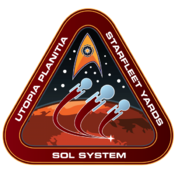Science Ships: Difference between revisions
No edit summary |
m (Adding Duderstadt) |
||
| Line 6: | Line 6: | ||
{{UP Class Link|Nova|Surveyor • 165 meters}} | {{UP Class Link|Nova|Surveyor • 165 meters}} | ||
{{UP Class Link|Horizon|Research Science Vessel • 400.25 meters}} | {{UP Class Link|Horizon|Research Science Vessel • 400.25 meters}} | ||
{{UP Class Link|Duderstadt|Deep Space Science Vessel • 578.5m}} | |||
{{UP Class Link|Oracle|Deep Space Science Vessel • 580 meters}} | {{UP Class Link|Oracle|Deep Space Science Vessel • 580 meters}} | ||
{{Utopia Planitia footer}} | {{Utopia Planitia footer}} | ||
[[Category:Starfleet ship classes]] | [[Category:Starfleet ship classes]] | ||
Revision as of 06:04, 26 March 2024
| Utopia Planitia Fleet Yards |
|---|
|
SCIENCE SHIPS Scientific pursuits remain at the forefront of Starfleet's agenda, and a range of science ships are specially designed and built for these missions. Many are modular, allowing different laboratory modules to be swapped in and out to reconfigure the ship for a specific mission with relatively little effort. Surveyors such as the Nova class are designed for short-range astronomical surveys and planetary research. The Oberth class has served as a mobile research laboratory for over a century. Newer deep space science vessels such as the Oracle class are capable of undertaking long-term missions without the need for as frequent refueling or resupplying as previous generations of science ships.
|
- Black-and-white ship illustrations by Tim Davies unless otherwise noted. Used with permission. All other images are copyright to their respective owners.
- Black-and-white ship illustrations by Tim Davies unless otherwise noted. Used with permission. All other images are copyright to their respective owners.
| REV SD 240103.26 |
|---|









